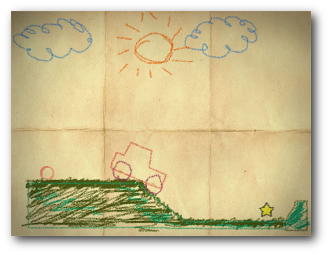As you may have noticed, I like my iPhone. But the iPhone is not just for playing games, or twitter, but can also be a useful tool for every stage of usability testing, from the discovery of customer needs to the iterative testing of potential designs and implementation. I’ve tried to compile five essential apps for usability professionals, available on the iPhone now. If anyone has any suggestions/additions, or disagrees with the choices I’ve made, please add your comments!
Working with usability requires a wide range of abilities, and hence these tools reflect the wide range of roles a usability professional may be performing. When talking about each app, I’ll try to cover where in the usability process it may come in useful, and how it can help you to increase efficiency and get better results.

but don't forget lo-fi alternatives
1. Pidoco°
Starting off, this isn’t strictly an iPhone app, but Pidoco’s software has been developed to be compatible with mobile browsers and the iPhone. I saw them demo the software at a recent UX Brighton event, and they impressed upon me that it was built with usability in mind. Pidoco offers a quick way to collaborate on the design of wire frames, and quickly show these to the user or client, without the need to be in the same geographic location as them. The easy to use nature of the system means it’d be ideal when iteratively testing an interface with users, and is a mid-fi alternative to paper prototyping. Currently offering a month’s free trial, there’s no excuse not to give it a go!
Pidoco°’s website: https://pidoco.com/en/
2. Mocha VNC
Need to mock up a mid-fi prototype of an iPhone App? You obviously don’t have time to make the app in Xcode, buy the iPhone developers license, link the customer’s phone to the computer and copy the app over. Instead, how about making a prototype on your Mac, or PC and using a VNC client to make the iPhone look at the prototype. The user will still be able to interact with the prototype by clicking, or navigating around, and the ‘controller’ sat at the server can display the correct pages to the user. Easy mid-fi prototyping, on an iPhone, without the long set up costs and investments required to actually have the app running on the iPhone.
Mocha VNC’s website: http://www.mochasoft.dk/iphone_vnc.htm
3. Camera
Watching someone perform a task is an important part qualitative usability testing. What about those moments where you weren’t looking, or noticed something that you wanted to ask about later, but forgot about? Looks like you need to be recording your user tests. Camera comes with all iPhones, but is only available for video recording on the 3GS. Since you are always likely to have your phone with you, it’s a handy mobile solution that allows you to record your usability sessions without requiring any additional equipment, so that they can be analysed later. Maybe buy a stand for it though!
4. exZact Data Collection
Quantitative research is also an important part of establishing user requirements, and working towards a design that meets their goals. The Data Collection iPhone app aims to allow you to create, and answer, custom surveys on the iPhone, collecting information like geographic location, and responses in a variety of forms (1-10 ratings, drop down lists, yes/no responses, and comment boxes). They then offer real time analysis, so you can see the results as they come in, and claim to be massively scalable. Offering a month’s free trial, it seems an effective solution if you require your data collection method to be mobile, and accessible anywhere.
exZact’s website: http://www.iformbuilder.com
5. Insight – Basecamp on iPhone
You’ve seen from the diversity of the apps above that a usability specialist has to be experienced in a lot of areas, and its often hard to keep on top of these. A tool that I have found invaluable in project management is Basecamp, which allows you to collaborate on projects, assign tasks and see what everyone is up to. Insight is a mobile version of Basecamp, and will allow you to keep up to date with how everyone working with you on the usability project is progressing from one easy interface, and keep on top of projects. As a busy person, it’s likely to be an invaluable tool to any usability specialist or contractor!
Insight’s website: http://www.encampapp.com/
Conclusion
Its clear from looking for the most useful usability apps for the iPhone that this is a largely untapped market – although there are tools available to help with the individual steps in the process, there is no one ‘go-to’ app for usability and UX professionals. What is needed is a more holistic solution, one that can work with a usability professional in every step of the process, from the initial requirement gathering stage, through building up personas of the customers, to the iterative design process and beyond. Until then we’ll have to make use of the wide range of apps covered today to achieve these tasks.
[…] View the Article and Steven’s UX Blog HERE […]